When you think about it, surfing and paddleboarding are both just sports that need you and a big flat board in the sea. However, there is more to these sports than meets the eye!
It is not just about a board on water but also the specifics of the board and how you use it to catch waves. But due to the similarity of both sports, people have long been asking the question… is there a difference between a surfboard and a paddleboard, or is it possible to use a stand-up paddleboard for surfing?
The answer is a big fat… yes! Apart from switching up your style and approach a bit here and there, there are no complicated equations or rocket science going on behind the scenes. If you’re up for a bit of salsa dancing on the seas, let’s see what you’ve got, cowboy!
Overview of Surfing and SUPing
The real difference is in how the apparatus of both sports is used. If you are SUPing (aka stand-up paddle boarding), you are usually required to buy or have a paddle with you to help you in making it from point A to point B.
Surfing, on the other hand, demands purely your body’s effort and movement to get you movin’ and groovin’. But if you’re interested in changing things a little and doing a bit of surfing on a paddle board; then you absolutely don’t need a paddle for that. You can also indulge in some windsurfing for more fun!
You don’t exactly need to purchase a paddle board if you want to learn paddle boarding. If you have a surfboard, then that works. The same is the case with surfing, if you have a paddle board lying around… wing it!
However, for those who need to be orderly in their activities and need separate equipment for each type of sport, you’re more than welcome to purchase separate boards.
But for budget babies like myself, it is not necessary. Now let me teach you how to surf on a plain old paddleboard!
How to SUP Surf with a Paddleboard?
First things first, you don’t exactly need to make any changes to your paddle boards if you already own one. It is all a matter of approaching the water, body position, applying foot pressure in the right places, and selecting proper locations.
Picking the Right Place
Paddleboarding in itself is usually done on calm waters, but if you’re going for a traditional surfing experience on a SUP board, then choose places with a lot more waves. Beaches and lakes with a healthy and steady flow of waves will help you practice balance and handle surprise scenarios on inflatable paddle boards.
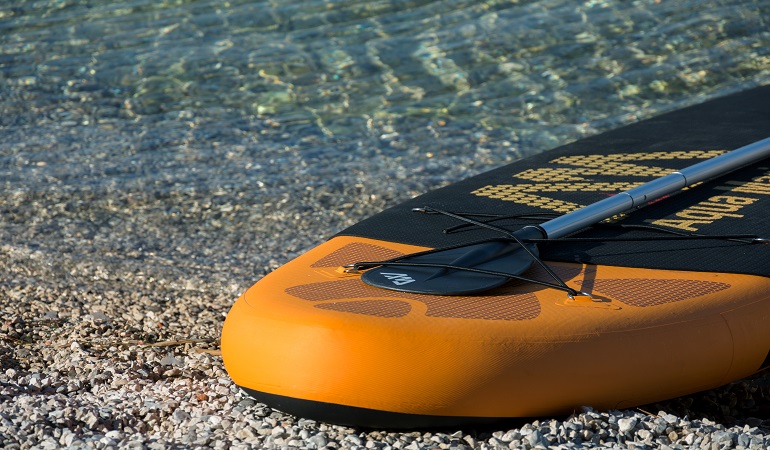
Paddleboard for beginners, start your SUP surfing with smaller waves on smoother water. The more frequent waves you catch, the more you will practice your balance and maneuverability.
It is highly advised that if your choice of location is a beach, then steer clear of the rocky bottom areas. Sandy beaches with equally sandy bottoms make for great starting points as it provides you with a safety guarantee if you slip up and fall.
To prepare yourself for push-off, find a smooth shoreline to begin your surfing on. Once you are familiar with and used to the smaller waves, the bigger ones will be easier to tackle.
The key is starting off at the right place to give yourself area and space for failure and re-attempts.
Getting into the Water
Your first step is what determines what the rest of your journey is going to be like. You’ve probably heard this cliché a hundred times, but it’s true! When getting into the water, you have to focus on making it past the shore, the first wave, and maintaining balance until you are standing atop the next wave.
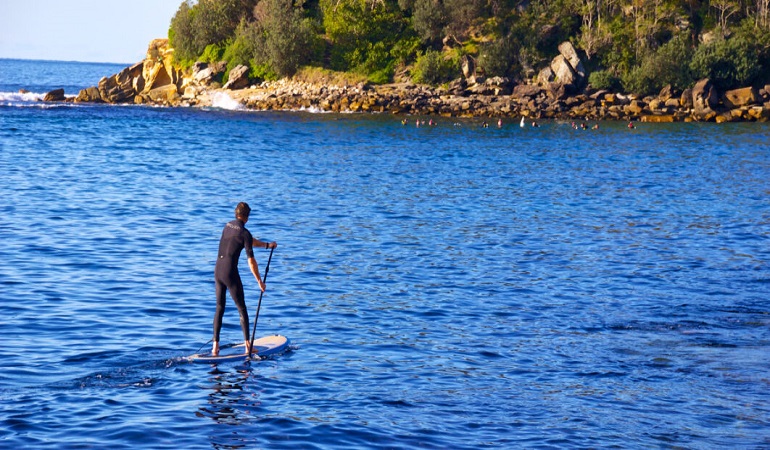
You need to keep your body and board angled perpendicularly toward each wave that comes your way. Paddle out into the water on your board (on your belly) and keep going till the water gets deep enough then push yourself up to a standing position and try to balance your weight equally all over the board.
Once your standing position has been achieved, you are now capable of riding small waves till you get the hang of things.
Paddling Through the Surf
After you have made it past the shore break, you now need to stand up to your full height on the SUP board to actually begin surfing. However, it is easier said than done since with a paddle board, one is used to calmer water.
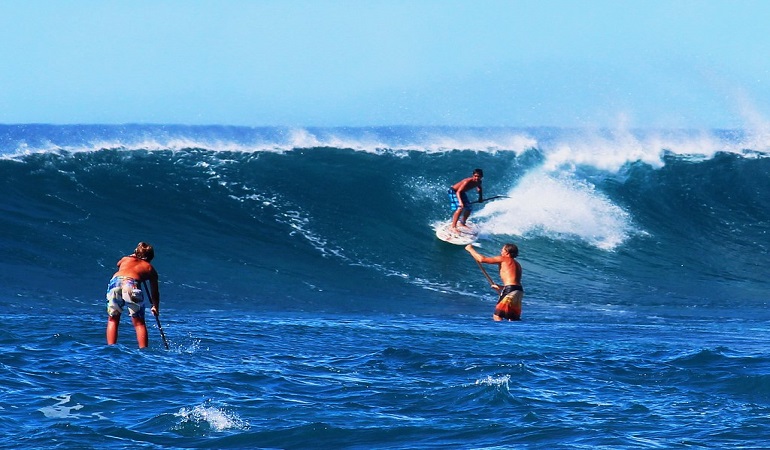
With riding waves and chops crashing into your paddle board, it would be twice as hard to maintain full standing position balance. This is why beginners surfing with SUP boards are advised to transition from laying on their bellies to kneeling (before finally standing).
Kneeling on your stand-up paddleboard helps you in gauging where to place your knees and feet to maintain perfect balance while standing. But, let it be said right here and right now that SUP surfing is going to involve a lot of tumbling over.
Each time you fall over from a standing position, take note of what went wrong in reference to where your feet were placed. Some SUP surfing enthusiasts switch from prone to a stand-up position as it forces them to ride waves earlier.
Moreover, where there is more chop in the water, it would help more if you tried to stand up quickly and immediately start paddling. The number of calories burned paddleboarding is also worth noting as it makes this activity a great workout for the entire body.
Best Positions for Facing the Waves
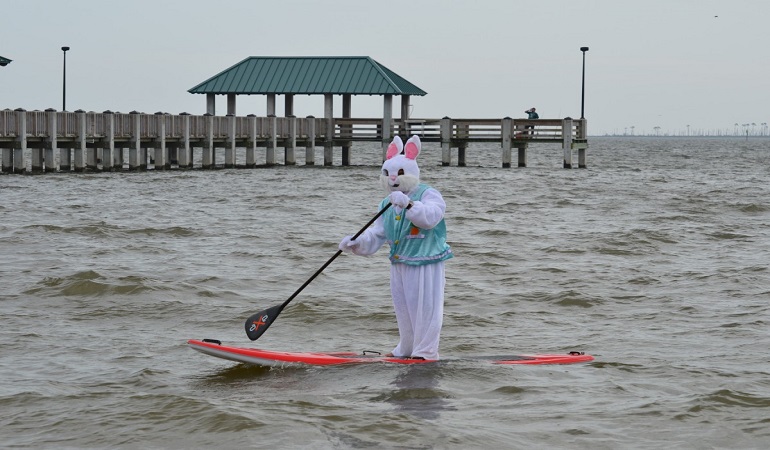
While paddle boarding on your blow up boards, you are quite used to planting your feet forward and positioning them parallel. However, as much as you may be tempted to utilize the same positioning, it would be more beneficial if you positioned one foot a bit behind the other.
Almost as if you are preparing to sprint or run, this stance helps stabilize your balance and prepare you for any surprise tumbles in the water.
Paddling into the Waves
Once you have managed to maintain a stand-up position on your SUP boards, you must move on to paddle waves while still on it without falling over.
A good way to brace a wave is first, to face it head-on, keep going in a perpendicular direction towards it, and once you hit it, do a strong paddle and shift your body’s weight back while propelling your feet to push the board against the wave.
Remember to relax your body while exerting pressure on the board so as to not cause your legs and ankles any pain or strain. Once you have mastered the art of standing up, paddling, and dominating small waves, you should move on to getting to the peak of waves.
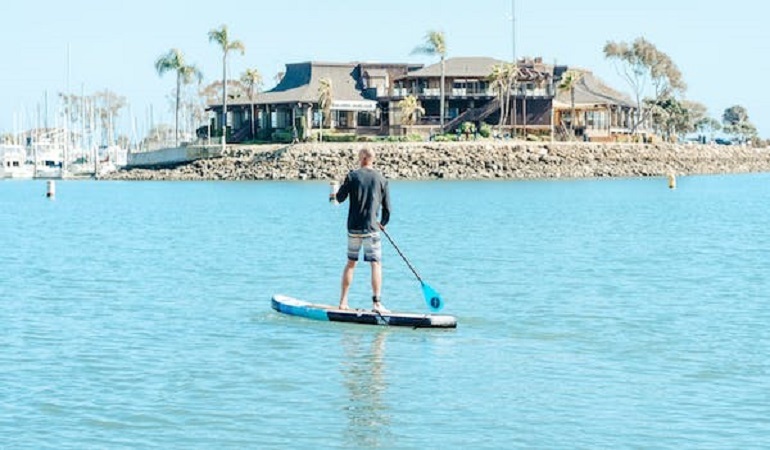
When practicing to get to the peak of waves, opt for the unbroken waves instead of whitewater, as they would provide your board with more stability and balance. So what you’ll need to do is find an oncoming unbroken wave, reach toward it, and once you are close, maneuver the SUP board to make it face the beach.
The last part tends to be the most tricky, as turning the board around leads to a lot of falling over if not done with grace and patience. However, practice makes perfect, and eventually, you’ll be able to make faster turns by utilizing the pivot turn strategy.
This technique is accomplished by pushing your rear foot toward the board’s tail as you turn and taking circular paddle strokes on the side opposite to where you’re turning. Now, as you’re facing the beach, work hard on paddling before the wave’s force reaches you.
This will increase your momentum (as you lost some of it by making the pivot turn).
You can also ride a wave by directing your board parallel to it and as soon as it reaches you, do some hard strokes, face the beach and drop the wave.
Riding the Waves
Rule number one from the surfer handbook is that with small waves it is always easier to paddle into them instead of riding them.
The process starts off easy as you first need to slide down the wave and then smoothly transition to standing on the board placing your dominant foot by the tail of the board and tensing your core. The effort you exert on the water should come from your leg and torso muscles.
Every expert surfer will tell you that in order to ride each wave easily you need to angle your body perpendicularly to it and each time a wave courses your way, do a strong stroke, lean backward and push all your body weight into the wave.
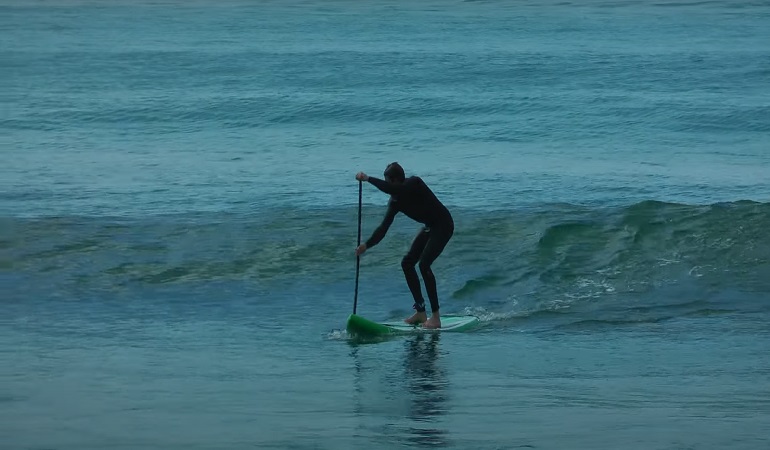
When braving big waves, it is natural to feel the push and force in your legs and ankles so remember to not push against the motion too much, and relax. Try your best to allow Mother Nature and her sweeping waves to guide you along the waters, and somehow go with the flow!
Getting out of a Wave
Finally, when you feel like you are done surfing for the day, you can get out of the waves by either using your paddle to slow yourself down or hopping off the board and holding the leash steady.
You can also steer the board with your feet outside of the wave, but that is for a bit more experienced stand-up paddleboard surfers.
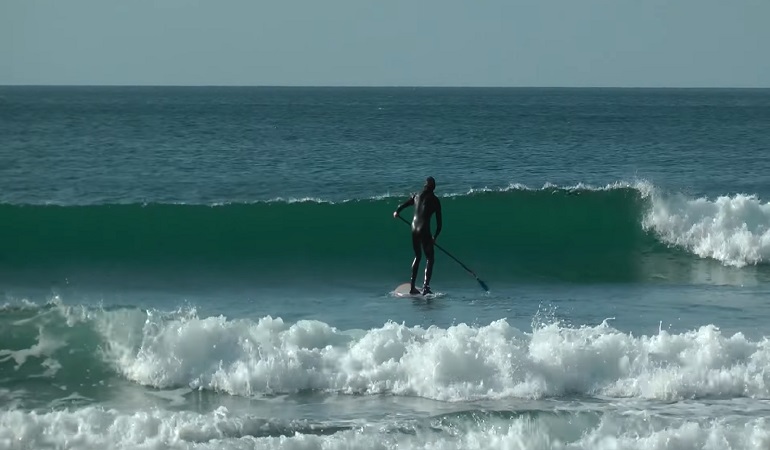
What Characteristics Should the Best Stand-up Paddle Board Have for Surfing?
Let’s break down the important features of a perfect paddleboard to learn SUP surf in water:
Material: Inflatable VS Hard Boards
Inflatable Board
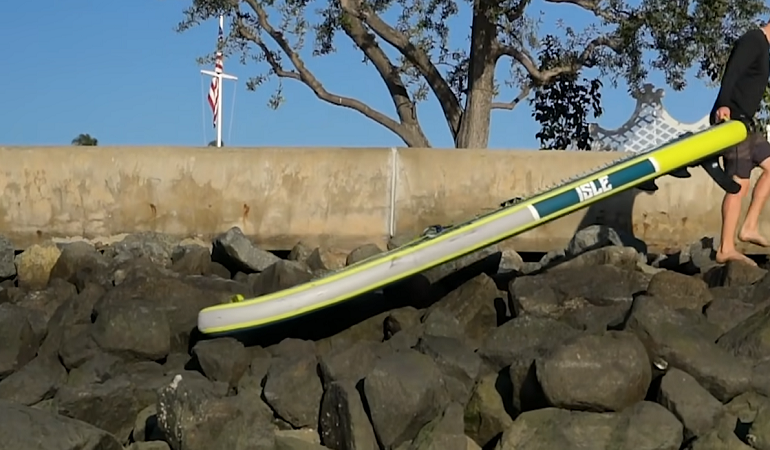
A more versatile board to opt for, inflatable paddleboards are suitable for surfing as well as other non-strenuous and relaxed activities like simple cruising. With a softer and more comfortable surface, they prove to be wonderful choices for beginners.
Why?
For starters, frequent tumbles on the board won’t prove to be as painful, and transitioning from kneeling to standing will be easier as you won’t have to deal with bruised/achy knees.
Hard Board
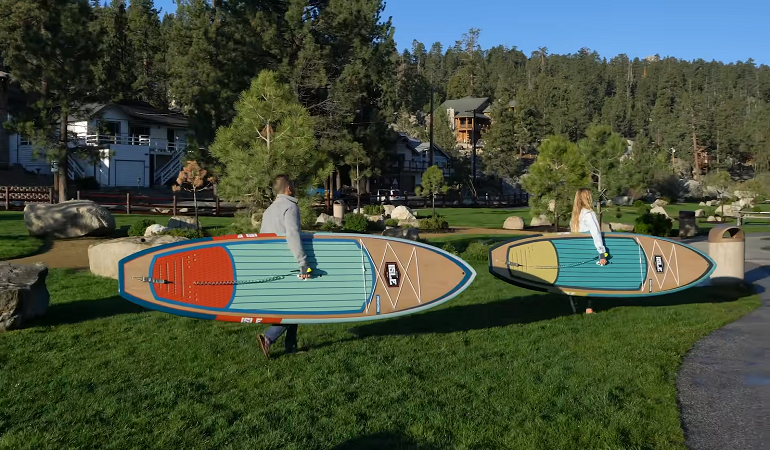
You could say these are a better choice for the more advanced SUP surfer. A hardboard has rails that are finer and more chiseled than an inflatable paddle board, therefore, improving your speed and command over it in the water.
Moreover, hard boards are smaller in comparison and not as heavy but prove to be tougher to travel and commute due to their non-condensing feature.
Size
The best SUP boards for surfing are advised to be in the range of 9 feet in length and 30 inches in width. Remember, the smaller they are, the better, as you can balance better on them.
It is worth remembering that if you are buying a SUP board for surfing, then go for a size smaller than what you usually choose when cruising. So if you cruise on a ten-footer, opt for a 9 footer for surfing.
Paddle
You can’t possibly think you can go without a paddle… while surfing… on a paddle board. Carbon paddles are a top favorite and are highly recommended due to their incredibly lightweight and practical feel.
As for the paddle size, that depends on your height as you should generally opt for a paddle that is almost as long as you in height. However, if you’re thinking of cruising on your paddle board, then your paddle should be a few inches taller than you.
Shape
Find yourself something that resembles a surfboard as much as possibly can. Paddle boards looking like floaters or canoes should be wholly avoided as they aren’t the best option for SUP surfing.
Deck Pad
As mentioned before, if you’re a beginner at SUP surfing you will be spending a lot of time tumbling and falling off your board. This means you will most likely bounce off a few bones and body parts off it.
Therefore, a deck pad is not only a dire need but also should cover a majority of the top of the board. Moreover, the tail (rear end) of your stand-up paddleboard should have a raised edge to prevent your back foot from slipping off when you are in full surfer mode.
An arch bar is another great and very useful part of your deck pad as it helps you exert more pressure on the tail to pivot turn by allowing you to position your back foot on the right spot without visually checking it.
Should I Buy an Inflatable or Hard Board for SUP Surfing?

Whether or not you should go for an inflatable or hardboard, the choice depends on your answer to one question. Do you want to do pure SUP surfing on your board or switch between cruising and SUP surfing?
Inflatable specialized SUP surfing boards are an impeccable choice if you are doing some laid-back cruising and a bit of non-serious, non-competitive surfing. However, if you are diligently looking to break some sweat and seriously get some sick moves in, then switch to a hard board.
With more freedom and control over your turns, pivots, and acceleration, you will find yourself more experienced and knowledgeable about SUP surfing with a hard board.
Conclusion
Learning to surf with a stand-up paddleboard is like learning how to bake a cake. It is never impossible, and everyone can do it with a bit of practice and technique correction.
0 Comments